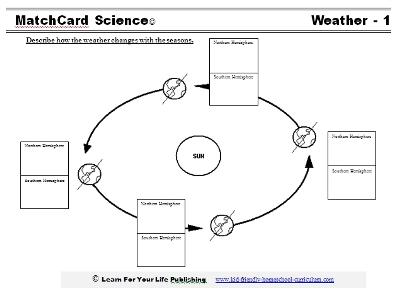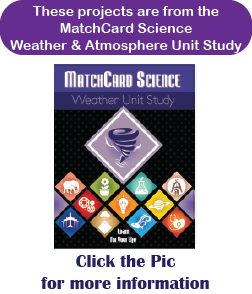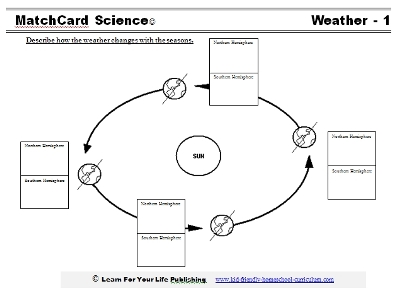Weather Lessons
Different Seasons in Different Hemispheres
The first of our weather lessons demonstrates different weather in opposite hemispheres.
Free Download Below


Changing Seasons MatchCard


Click the image to go to the download.
This is MatchCard #1 of the Weather Unit Study. Find more information on MatchCard Science below.
MatchCard Science Changing Seasons MatchCard
Objective: Describe how the weather changes in the two hemispheres with the different seasons.MatchCard: Download below.
Students match the four seasons to the diagram of the earth and sun. They need to differentiate the seasons in the northern and southern hemispheres. Your students will match the seasons with the diagram of the earth and sun.
Our Other Weather Lessons
The MatchCard Weather Unit Study includes lessons on:- Weather Instruments
- Water Cycle
- Types of Precipitation
- Wind Speed
- Cloud Types
- and MORE
Explore the Changing Seasons
The Earth's Revolution and Rotation
This activity is best done with a globe to represent the earth and a strong portable light source to represent the sun.Review that the earth rotates on its own axis, and revolves around the sun. Use the globe and light source and have the students explain how the earth's rotation causes day and night.
Review that the earth revolves around the sun one time in 365 days or one year.
The Earth's Tilt on its Axis
If the earth was sitting straight up and down there would be no changing seasons. Imagine a pencil going from the north pole through the earth and coming out of the south pole. A straight earth would have a straight pencil.But the earth is actually tilted at a 23.5 degree angle. Demonstrate that tilt to the student.
When the North Pole is closer to the sun, the people in the northern hemisphere have summer and the people in the southern hemisphere have winter. As the earth revolves around the sun, the angle of tilt remains the same. The top of the pencil would be pointing at the same stars - or in your case at the same side of the ceiling.
As you move to the opposite side of the sun with your globe, students can see how the south pole and southern hemisphere get more sun when the northern hemisphere has the cold winter months.
Younger students may need to see this demonstration several times before it makes sense to them.
Look at the Changing Seasons Matchcard. The students can explain how the summer and winter months are opposite from looking at the diagram.
How Big is 23.5 Degrees?
Just how big is that tilt? Use a paper plate or a paper circle (use a regular plate as a stencil) to show the earth's tilt.Fold the paper in half and cut out the half. That is a one hundred eighty degree angle.
Fold the paper in half again to make a quarter of a pie. This is a 45 degree angle.
If you fold it in half one more time (one eighth of a circle) you would have 22.5 degrees. The 23.5 degree tilt of the earth's axis is just a little bit more than this.
Have students use their pencils to estimate a 45 degree tilt and a 22.5 degree tilt.
Solstice and Equinox
Explain that there are two soltices a year. At that point the poles are tilting the furthest or the closest to the sun.Soltice
The date of the soltices change very slightly every year.- June 21st is the most common date for the summer soltice for the northern hemisphere and winter soltice for the southern hemisphere.
- December 21st is the most common date for the winter soltice for the northern hemisphere and summer soltice for the southern hemisphere.
Equinox
Equinox refers to the two dates when the sun is midway between the soltices.- March 20 is the most common date for the spring soltice for the northern hemisphere and fall soltice for the southern hemisphere
- September 22 is the most common date for the fall soltice for the northern hemisphere and spring soltice for the southern hemisphere
Temperate Zone
If you live near the equator, you have hot weather all year around. If you live on the North or South Poles, it is colder much of the year. If you live in the temperate zone, you have the four seasons.Tropic of Cancer
The northern temperate zone is 23.5 to 66.5 degrees north latitude. It starts at the Tropic of Cancer and goes to the Arctic Circle.Tropic of Capricorn
The southern temperate zone is from 23.5 degrees latitude south at the Tropic of Capricorn to the Antarctic Circle at 66.5 degrees south. Hmmm, there’s that 23.5 degree tilt again. On a map of the Earth, locate and color:- Equator
- Tropic of Cancer
- Tropic of Capricorn
- Arctic Circle
- Antaractic Circle
- Northern Temperate Zone
- Southern Temperate Zone
MatchCard Science
How To Use MatchCards

Download the FREE MatchCard Science Instructor's Guide and see how MatchCards can make building their science knowledge base fun.
Weather Unit Study

Nine different weather lessons can be presented in this 4 week study.
Download the entire Weather Unit Study.
12 Science Unit Studies

Chemistry is only one of twelve complete unit studies for kids in 3rd to 8th grade.
Comprehensive objectives, hands-on projects, suggested science fair experiments, and the fun game-like MatchCards keep them interested in learning science. See all twelve MatchCard Science Unit Studies.
About Our Site
Hands-On Learning













